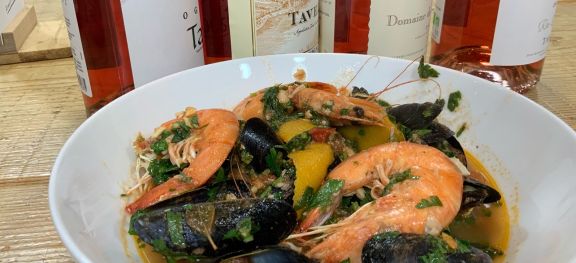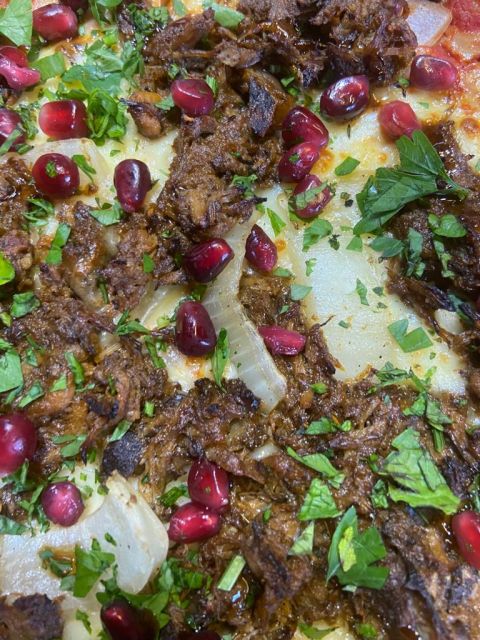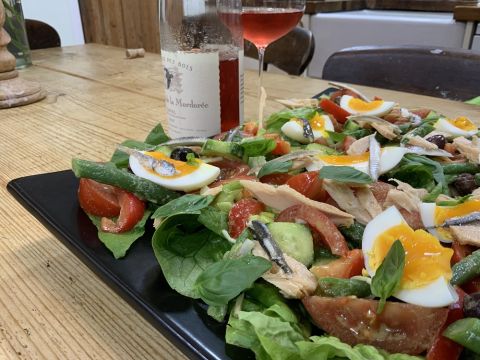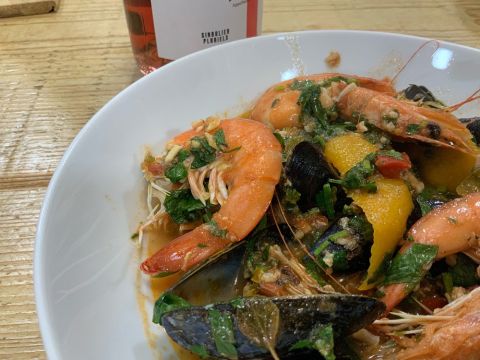Food pairing: Tavel trouble

8 December 2022 You may have heard Tamlyn Currin chatting with Jancis on our first-ever podcast this week. Here, in our Throwback Thursday dive into the archives, Tam expounds on some of the principles of food and wine matching that she and Jancis talked about.
21 September 2021 As usual, Tam has worked hard at her table, all on our behalf.
Ten days of tasting Tavel had me hunting through books and websites looking for the perfect Tavel foods. A wine with more than 200 years of history must have some pretty tried and trusted pairings – classic pairings, surely?
To my surprise, not really. Tavel, everyone tells me, goes with charcuterie, cheese, fish, chicken, duck, seafood, veal, pork and beef. It goes with pasta, spicy foods, fruit, garlic, quail, Mediterranean food, soup, roast vegetables and spring salads. It’s a barbecue wine, a pizza wine, a Chinese-takeaway wine, a curry wine. Everything, then.
Except it doesn’t.
One source suggested lobster bisque. It was a terrible suggestion. Don’t bother. Fruit? Not good at all. Cheese? Meh – although better with soft creamy cheeses than hard cheeses. It made a decent, if not radically exciting pairing with roast chicken, as well as several different salads. It’s fine with beef steak and beef burger, having the body to cope perfectly well with red meat. We tried various Tavels over ten days with various meals and, yes, very few clashes, but also very few revelations. It’s a good all-rounder and is certainly a wine for all seasons in terms of food, perhaps leaning more towards autumnal and winter dishes than very light summery foods. You could, in a nutshell, rely on it if you were serving lots of very different dishes at once (buffet, tapas, bring-and-share barbecue, picnic etc), or if you’re out for a meal and everyone has ordered something different. It would keep the red, pink and white drinkers happy. Oh, and yes, charcuterie is decent, especially good-quality chorizo.
But, having discovered how exciting Tavel is as a wine in itself, I wanted more than generic crowd pleaser. I wanted fireworks.
I found them.
Artichoke – that notoriously anti-wine-friendly vegetable – was suggested by several sources. Artichokes contain cynarin, an ester which plays puckish tricks with the taste receptors on our tongue, making everything taste weirdly (and slightly metallically) sweet afterwards, albeit briefly. Mention artichokes and sommeliers shudder, raise their eyes to heaven and pray. Fiona Beckett says that she finds that the effect is most pronounced with boiled artichokes; braised artichokes seeming to be less aggressive with their taste-bud dupery antics. I couldn’t get my hands on fresh artichokes to check out the boiling v braising theory, but armed with a can of artichokes in water and a jar of artichokes in oil, I put Tavel to the test.
Yes, a bite of artichoke (both kinds) made the wine taste sweeter – but somehow it was OK. Many Tavels have that interesting bitter-pastis-like streak and the accentuated sweetness played with that bitterness, almost making the wine more aperitif-like, even a little like rosé vermouth. I liked the sweetness effect. It also accentuated the dried herbs in the wine, the earthy herb-leaf slant of the artichokes. And then I dipped the artichoke into a slick of aioli… There. Right there. The fireworks. Garlic is another ‘game-changer’, as Victoria Moore refers to foods that mess with wine. So, it was a total revelation to discover that the combination of two aggressive game-changers at once, with Tavel, was a match good enough to buckle knees.
There was another surprise. Tuna steak also cropped up fairly often as a good match for Tavel. We tried it. We tasted it, looked at each other, shrugged. Not bad. But then, impulsively, I stuck a bit of the tuna steak in a sweet chilli dipping sauce – that combo was sensational with a mouthful Tavel! Not what I’d expected at all. Sweet-chilli dipping sauce and dry wine is not normally a good combination.
Duck was interesting. We seared one breast, smoked another. The Tavel coped with competence. I then tried the combo with the addition of a sour-cherry sauce. Horrible. Then, again impulsively, I grabbed a jar of maraschino cherries. Brad leaned back in horror. He hates maraschino cherries at the best of times. The thought of eating them with smoked duck had him in full flight-fight-freeze mode. He literally moved his chair several inches away from the table (and my proffered fork). But I’m nothing if not stubborn, insisting that, in the name of selfless research we must both try maraschino cherry + slice of smoked duck + sip of Tavel. Ha! Another Catherine wheel! Even my maraschino-shunning partner stopped, raised his eyebrows, and reluctantly confessed that I may well be onto something.
A friend of ours, a gentle giant of a man who wears flour on his t-shirts like the rest of us wear perfume, makes the most scrumptious artisan pizzas from his garage for a living. (Shameless shout-out for Howard D'Pizza Guy right here.) The one evening he delivered his newest creation: a pizza loaded with Lebanese-spiced pulled lamb, tahini-harissa sauce, fresh mint, rocket, pomegranate seeds and pomegranate-molasses drizzle we had Tavel on the table (surprise, surprise).
The pizza was sensational, and the pairing pinged on the herbs and spices, tucked into the sweetness of fruit and lamb and molasses, creamed into the nuttiness of the tahini. So, Tavel might well be the perfect (and I really mean the emphasis on perfect) answer to a Middle Eastern meal where the dishes range from hummus and ezme to lamb and grilled fish, where the flavours are intense, spiked with fresh, pungent green herbs, popping with bright chilli, rich with pools of olive oil, smoky from the grill, sharp with fresh lemon and yogurt, fragrant with cinnamon, sumac, cumin and coriander. Tavel answers all those elements with tympanic joy.
But my two favourite pairings of all were the simplest. And, in my opinion, the best.
The first was Niçoise salad. After having read Felicity Cloake’s deconstruction of what makes the most authentic, perfect Niçoise salad, I was thoroughly confused, so went with French green beans, cucumber, tomatoes, kalamata olives, semi-soft boiled eggs, ‘posh’ tuna (from a jar of oil), anchovies, capers, fresh basil leaves, finely sliced spring onions and Cloake’s delicious salad dressing. Multiple-game-changer-ingredients alert: garlic, vinegar, anchovies, spring onions. Tavel waltzed around the room, swept the salad up in its arms, and waltzed around the room again – in perfect step.
The second was fish soup, Fiona Beckett’s suggestion. I followed Nigel Slater’s recipe pretty closely, complete with chillies, spring onions and coriander, but I also added some fat head-on prawns. That pairing was nothing short of stellar. The depth and richness of flavour, the heat of the chilli, the fragrance of the orange and bay leaves, the brightness and intensity of the tomato, the sweetness of the fish and seafood, together with the Tavel, was nothing short of addictive.
I may have had three bowls.
With three glasses of wine.
Brad tells me four.
Don’t judge.
Become a member to view this article and thousands more!
- 15,428 featured articles
- 273,974 wine reviews
- Maps from The World Atlas of Wine, 8th edition (RRP £50)
- The Oxford Companion to Wine, 5th edition (RRP £50)
- Members’ forum
- 15,428 featured articles
- 273,974 wine reviews
- Maps from The World Atlas of Wine, 8th edition (RRP £50)
- The Oxford Companion to Wine, 5th edition (RRP £50)
- Members’ forum
- Commercial use of our Tasting Notes



